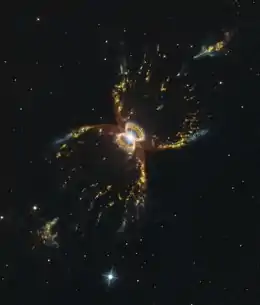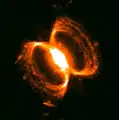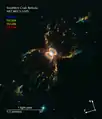Southern Crab Nebula
The Southern Crab Nebula (or WRAY-16-47 or Hen 2-104) is a nebula in the constellation Centaurus. The nebula is several thousand light years from Earth, and its central star is a symbiotic Mira variable - white dwarf pair. It is named for its resemblance to the Crab Nebula, which is in the northern sky.
| Emission nebula | |
|---|---|
| Planetary nebula | |
 | |
| Observation data: J2000 epoch | |
| Right ascension | 14h 11m 52.06s[2] |
| Declination | −51° 26′ 24.1″[2] |
| Distance | 7,000 ly (2,100 pc)[3] ly |
| Apparent magnitude (V) | 14.20[2] |
| Constellation | Centaurus |
| Notable features | Has a symbiotic star system at its center |
| Designations | V852 Cen, Hen 2-104, IRAS 14085-5112, PN G315.4+09.4, Wray 16-147, 2MASS J14115206-5126241 |
The Southern Crab was noted in a 1967 catalog, and was also observed using a CCD imager with the 2.2 meter telescope at the La Sila observatory in 1989.[4] The 1989 observation marked a major expansion of knowledge about the nebula, and it was observed using various filters.[4]
The nebula had already been observed using Earth-based telescopes,[4] but images taken with the Hubble Space Telescope in 1999 have provided much more detail, revealing that at the center of the nebula are a pair of stars, a red giant and a white dwarf. It was imaged again by HST in 2019 with a newer instrument.
In 1999 it was imaged by the Hubble Space Telescope's Wide Field and Planetary Camera 2,[5] noted for its unique "stair-step" crop and for such astrophotos as the Pillars of Creation.
The WFPC2 images were taken at a optical light wavelength of 658 nm.[5]
The nebula was imaged again by the Hubble Space Telescope in 2019, and a set of images to celebrate the anniversary of the space telescope's launch in 1990 (29 years) by the Space Shuttle.[6] This time a newer camera the WFC3 was used to image the nebula, at wavelengths filters of about 502, 656, 658, and 673 nanometers.[7]
The designation He2-104 (or Hen 2-104) comes from the Henize catalog of 1967, Observations of Southern Planetary Nebulae.[8] The catalog includes 459 items identified as planetary nebula (or likely as such).[9] (note that in this meaning it does not imply exoplanets)
Another designation that it has been recorded for this object is WRAY-16-47.[10]
In 2008, an investigation of the Southern Crab with its symbiotic (astronomical term) star was published.[11] The study used imaging and spectroscopic data from space and Earth-surface telescopes including Hubble and VLT observatories.[11] The ESO defines a symbiotic star system as "binaries in which a small hot star (white dwarf or main sequence star) orbits around a red giant star. These systems are often surrounded by an envelope of gas or dust; those with gas are known as S-types and those with dust as D-types."[12]
Gallery
 Close up of the center of the Nebula
Close up of the center of the Nebula The Southern Crab Nebula in its entirety
The Southern Crab Nebula in its entirety Southern Crab Nebula – (18 April 2019;annotated)
Southern Crab Nebula – (18 April 2019;annotated) Southern Crab Nebula – (18 April 2019;Shape)
Southern Crab Nebula – (18 April 2019;Shape)
See also
References
- "Hubble Celebrates its 29th Birthday with Unrivaled View of the Southern Crab Nebula". www.spacetelescope.org. Retrieved 18 April 2019.
- "Hen 2-104". SIMBAD. Centre de données astronomiques de Strasbourg.
- "The Southern Crab Nebula, a planetary nebula in Centaurus". Anne's Astronomy News. Retrieved 22 January 2017.
- Chiu, Liang-Tai George (August 1980). "Space Telescope Astrometry from CCD images". Celestial Mechanics. 22 (2): 191–196. doi:10.1007/bf01228806. ISSN 0008-8714.
- [email protected]. "Southern Crab Nebula". www.spacetelescope.org. Retrieved 2019-09-17.
- Hille, Karl (2019-04-18). "Hubble Celebrates 29th Anniversary with the Southern Crab Nebula". NASA. Retrieved 2019-09-17.
- [email protected]. "The Crab of the Southern Sky". www.spacetelescope.org. Retrieved 2019-09-17.
- "List of Common Deep Sky Catalogs". www.messier.seds.org. Retrieved 2019-09-17.
- Henize, Karl G. (1967-04-00). "Observations of Southern Planetary Nebulae". The Astrophysical Journal Supplement Series. 14: 125. doi:10.1086/190151. Check date values in:
|date=(help) - 15677 - Spectroscopy and Imaging of the Southern Crab Nebul
- "Hen 2-104: A close-up look at the Southern Crab". ResearchGate. Retrieved 2019-09-18.
- [email protected]. "The "Southern Crab" Nebula". www.eso.org. Retrieved 2019-09-18.
External links
| Wikimedia Commons has media related to Southern Crab Nebula. |
- The "Southern Crab" Nebula (He2-104) in 1989 (captures the crab like presentation)